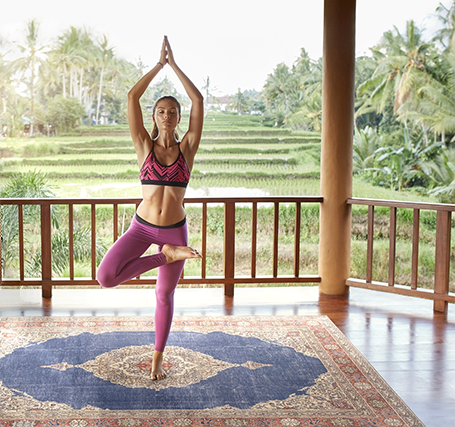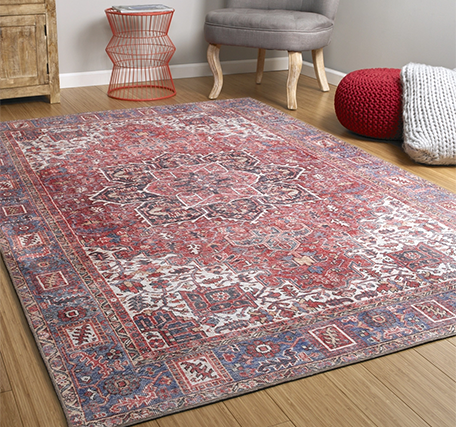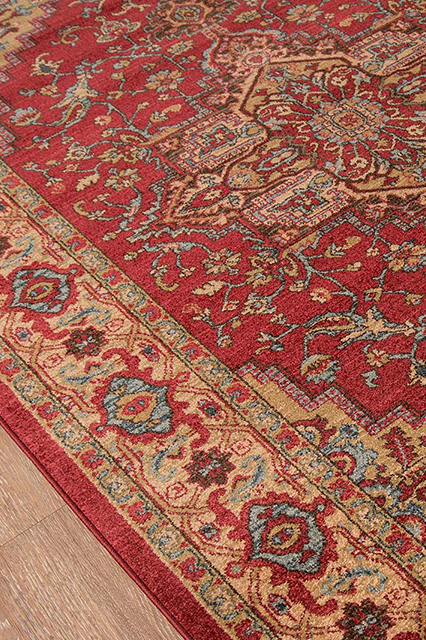What Are the Features of Persian Rugs?
September 16, 2022

Persian rugs are one of the most popular rugs in the world. They are hand-knotted and made with natural materials like wool or silk. They often have intricate designs and are available in various colors. Most people don’t realize that Persian rugs are made in Iran while Oriental rugs are made in Turkey, China, and India.
Many people use Persian rugs as floor coverings or wall hangings because they add elegance and warmth to a space. Persian-style rugs can be an excellent way to add color, texture, and interest to any room.
Materials Used in Persian Rugs
Persian rugs are usually made of wool but are also made with other materials such as:
Cotton
Cotton is often used for the foundation of the rug, as it is strong and durable. The cotton warp and weft threads are tightly woven, resulting in a firm foundation that can support the complex designs of the rug.
Cotton is also soft to the touch, making it a comfortable material for walking and lying on. However, cotton rugs may not be as durable as wool or silk rugs, as they are more susceptible to wear and tear.
Silk
Silk is known for its softness and shine, making it a luxurious material that adds a touch of elegance to any space. Silk is also tough and durable, making it an ideal choice for high-traffic areas.
Silk is resistant to stains and fading, allowing Persian rugs made from this material to retain their beauty for many years, making it an excellent choice for those seeking a luxurious and long-lasting Persian rug.
Goat Wool
Goat wool rugs have a soft, silky texture similar to cashmere. It’s strong, durable, and naturally flame-resistant, making it an ideal choice for use in carpets. The fibers can also be dyed to create a wide range of colors, allowing Persian rug makers to create truly unique designs.
Camel Wool
The material is known for its unique silky appearance and feel. Regarding quality, camel wool is considered one of the strongest and most durable fibers and has natural self-cleaning properties.
Camel wool is also prized for its softness, durability, and unique coloration. It is also one of the most ethical and sustainably sourced animal fibers for making area rugs.
Motifs Used in Persian Rugs
Persian rugs are often designed with repeating patterns and focus more on objects and shapes rather than figures or faces. They usually feature a variety of motifs, which can be broadly categorized into these main types:
Boteh
The Boteh motif is one of the most famous motifs used in Persian rugs. Also known as the paisley, this teardrop or almond-shaped motif has a curved upper edge and is ideal for creating larger patterns or tesselations. It uses different techniques, including weaving, knotting, and embroidery.
The Boteh motif is often used to symbolize fertility, prosperity, and immortality, and it is believed to bring good luck to those who own a rug with this motif.
Gul
The Gul, also known as the flower or rose motif, is one of the most common motifs in Persian rugs. Overlapping petals create this motif to form a rosette, often used to fill negative space in a design.
The Gul can symbolize several different things, depending on its color and position within the rug. For example, a red Gul often symbolizes sunsets and dawns, while a white Gul can represent purity or innocence. In some cases, the Gul may also represent the eye, protecting against evil spirits.
Herati
The Herati motif is believed to symbolize good fortune and prosperity. The motif consists of a diamond-shaped medallion with a curving stem that extends outwards into four leaves. Each leaf is then divided into smaller compartments containing a small dot or lozenge.
The overall effect is decorative and symmetrical, making the Herati motif easy to recognize. The Herati motif is also often used to create a sense of movement and energy in a rug design.
Mina-Khani
The name comes from the Persian words for “flower” and “eye.” It typically features a central medallion with radiating petals. The motif is often used to symbolize the sun and is said to represent the universe in its entirety.
The Mina-Khani motif is created using a technique known as double knotting, in which each strand of wool is knotted around two adjacent warps. This creates a dense and sturdy fabric that is highly resistant to wear and tear.
Shah Abbasi
This motif is based on a 16th-century Persian carpet owned by Shah Abbas I, and it features a central medallion surrounded by elaborate floral and geometric patterns. The Shah Abbasi motif is often associated with wealth and power, as it was traditionally only used in rugs made for royalty or nobility.
Today, the Shah Abbasi motif is still revered for its beauty and symbolism and is often used in high-end Persian rugs.
Colors Found in Persian Rugs
One of the most distinctive features of Persian rugs is their use of color. Persian rug makers often use bright and bold colors to create intricate designs that are both eye-catching and meaningful. Some of the most commonly used colors in Persian rug design include:
Green
Green is associated with growth and new life. This makes it a popular choice for rugs to commemorate special occasions such as births or weddings. Green is also a restful color that can help to create a tranquil atmosphere.
Red
Red symbolizes power and wealth, making it a popular choice for those looking to make a statement. It is also believed to bring good luck and fortune.
Blue
Blue is often said to represent the heavens, and it is also used to symbolize spirituality and purity. Blue is also often used to create a sense of depth and perspective. Rugs with blue colors are often highly prized by collectors.
White
White is a symbol of purity, innocence, and new beginnings. It is often used in Persian rugs to represent spiritual values and concepts such as heaven, paradise, and perfect harmony. White can also be used to create a sense of calm and serenity, making it an ideal color for prayer rugs or meditative designs.
Brown
Brown represents nature and the earth, making it a grounding color. It also symbolizes strength and stability, vital qualities in a Persian rug.
Gold
The color gold represents wealth and success, making it a popular choice for those hoping to attract good luck. Gold is associated with the sun and fire, so it is ideal if you want to create a warm and inviting space.

Types of Persian Rugs
There are many different types of Persian rugs, each with unique features. Some of the popular styles include:
Tabriz
Tabriz rugs originate from the city of Tabriz in Iran. The most common motifs used in Tabriz rugs are flowers, birds, and geometric patterns. The colors used are typically blue or red, with shades of ivory and green.
The pile of a Tabriz rug is usually made from wool, although silk can be used for the foundation. The carpets are typically double-knotted, making them durable and particularly good for high-traffic areas like the living room. Tabriz rugs are considered to be some of the finest Persian rugs available on the market today.
Keshan
The Keshan style of Persian rug originates from the city of Keshan in northwestern Iran. Keshan rugs are typically woven with medium- to high-quality wool, often featuring designs that include geometric patterns and floral motifs. The color palette of Keshan rugs is usually muted, with ivory, beige, and light blue being the most common colors.
Kesan rugs are usually woven in sizes ranging from small to large, making them a versatile option for various spaces. Kesan rugs are popular for home and office settings thanks to their high quality and classic style.
Shiraz
Shiraz rugs originate from the city of Shiraz in Iran. Their great size characterizes them, often exceeding 12 feet in length. They also feature a high knot density, which results in a dense, plush pile. Shiraz rugs have intricate patterns, often incorporating red, blue, and ivory.
The designs on Shiraz rugs are often inspired by nature and often feature floral or Paisley patterns. Because of their large size and lavish designs, Shiraz rugs are often used as statement pieces in formal living or dining rooms.
Kirman
The Kirman rug is from the city of Kirman in southeastern Iran. It is characterized by its use of bold, geometric patterns and vivid colors. The pile is made from wool, and the foundation is cotton or wool.
In some cases, the design may also include elements of floral or paisley patterns. The Kirman rug is often considered one of the most beautiful Persian rug styles.
Heriz
The Heriz style originates from the town of Heriz in northwest Iran. These rugs are usually made of wool and feature a thick pile that can be either tightly or loosely woven.
The designs often showcase geometric patterns, including medallions, diamonds, and octagons. The colors are usually bright and bold, making them popular for formal or informal settings.
Sultanabad
The Sultanabad rug is a Persian rug that originates from the Sultanabad region of Iran. It is characterized by its large size, often reaching up to 12 feet in length. The pile is usually made of wool, and the colors are bold and vibrant.
Sultanabad rugs often feature geometric patterns and floral and animal motifs. Because of their durability, these rugs are popular in high-traffic areas such as living and dining rooms.
Sarouk
The Sarouk style of Persian rug originates from Kashan, Iran. It is characterized by its large size and intricate designs, which often feature flowers, birds, and geometric patterns. The wool used to make Sarouk rugs is typically dyed in natural shades of red, blue, and yellow, giving the rugs their distinctive appearance.
Sarouk rugs are typically made by hand using a loom using a Persian knot with double warp of cotton. Making a Sarouk rug can take several months to complete, depending on the size and complexity of the design. Due to their beauty and craftsmanship, collectors revere Sarouk rugs, often used as floor coverings in homes and businesses.

Call Today
Rug Goddess is an online provider of high-quality rugs. We offer a virtually unlimited selection of options, including color, shape, size, and brands. If you prefer, we can assist you with any custom-designed rug you may desire.
We offer exceptional prices on any of our rugs, including Persian, Moroccan style, Jute, and any other type of rug you may desire.
Many of our rugs have sample sizes available if you want to try them before you buy.
We offer free shipping within the continental United States on orders over $49 for deliveries.
Contact us today and let The Rug Goddess experts help you find and place an order for that perfect rug to complement your home or office decor.

